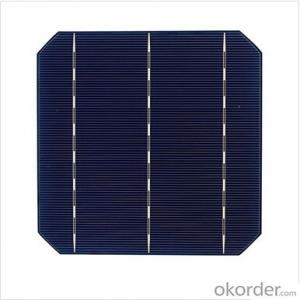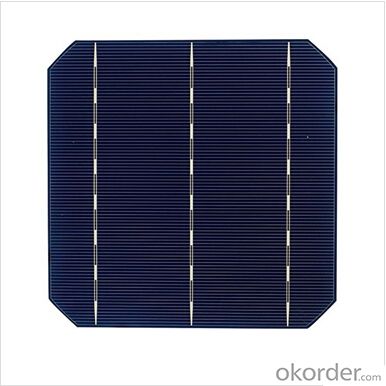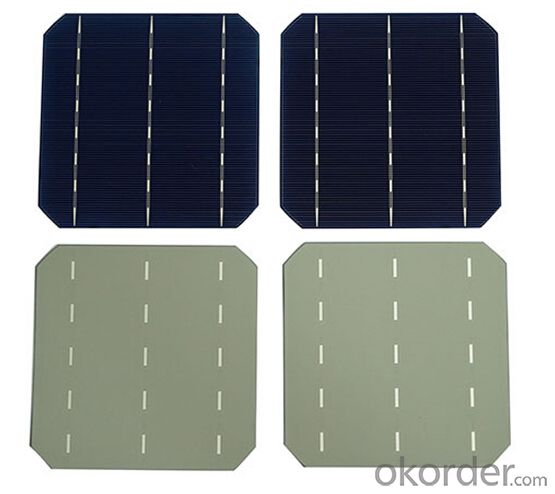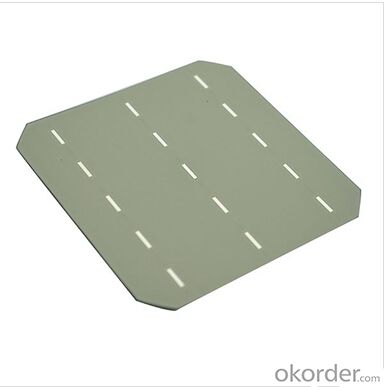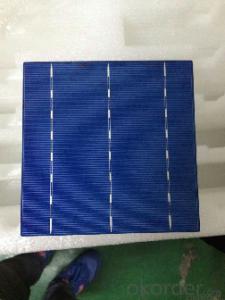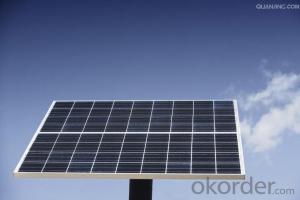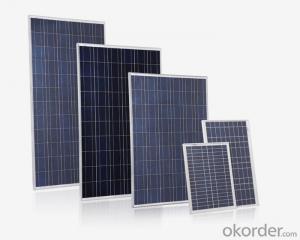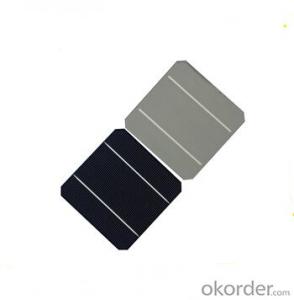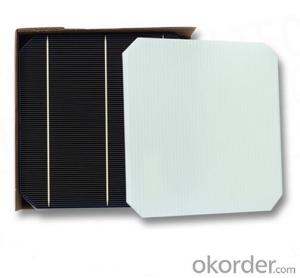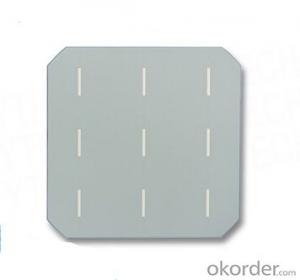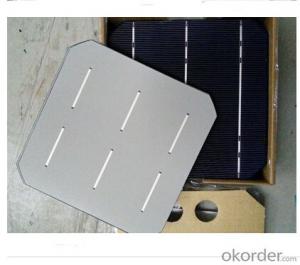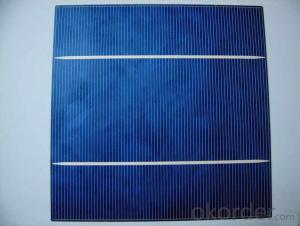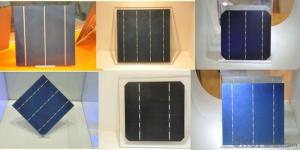A Grade 17.4% Monocrystalline Solar Cells and Modules
- Loading Port:
- Shanghai
- Payment Terms:
- TT OR LC
- Min Order Qty:
- 5000 pc
- Supply Capability:
- 800000 pc/month
OKorder Service Pledge
OKorder Financial Service
You Might Also Like
Monocrystalline Solar Cells A GRADE
A solar cell, is an electrical device that converts the energy of light directly into electricity by the photovoltaic effect, which is a physical and chemical phenomenon. It is a form of photoelectric cell, defined as a device whose electrical characteristics, such as current, voltage, or resistance, vary when exposed to light. Solar cells are the building blocks of photovoltaic modules, otherwise known as solar panels.
Advantage of Monocrystalline Solar Cells
• High efficiency and stable performance in photovoltaic conversion.
• Advanced diffusion technique ensuring the homogeneity of energy conversion efficiency of the cell.
• Advanced PECVD film forming, providing a dark blue silicon nitride anti-reflection film of homogenous color and attractive appearance.
• High quality metal paste for back surface and electrode, ensuring good conductivity, high pulling strength and ease of soldering.
• High precision patterning using screen printing, ensuring accurate busbar location for ease with automatic soldering a laser cutting.
Specifications of Monocrystalline Solar Cells
Efficiency (%) Pmpp (W) Umpp (V) Impp (A) Uoc (V) Isc (A) |
18.20% 4.43 0.536 8.263 0.634 8.712 |
18.00% 4.38 0.535 - 8.188 0.633 8.701 |
17.80% - 4.33 0.534 - -8.112 ---0.632 ----8.652 |
17.60% 4.28 0.533 8.036 0.631 8.641 |
17.40% 4.23 0.529 8.005 0.630 8.591 |
Applications of Monocrystalline Solar Cells
Assemblies of photovoltaic cells are used to make solar modules which generate electrical power from sunlight, as distinguished from a "solar module" or "solar panel". A solar array generates solar power using solar energy.
Packaging & Delivery of Monocrystalline Solar Cells
Carton Box Package and Deliver by air. It should be noticed that it should be avoid of water, sunshine and moist.
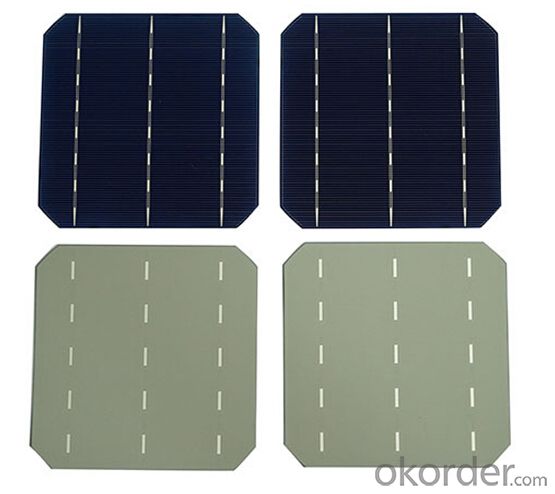
FAQ
We have organized several common questions for our clients,may help you sincerely:
①What price for each watt?
It depends on the efficiency of the solar cell, quantity, delivery date and payment terms.
②How long can we receive the product after purchase?
In the purchase of product within three working days, We will arrange the factory delivery as soon as possible. The pecific time of receiving is related to the state and position of customers.Commonly 7 to 10 working days can be served.
③Can you provide the peripheral products of the solar panels, such as the battery, controller, and inverter? If so, can you tell me how do they match each other?
Yes, we can, we have two companies for solar region, one is CNBM International, the other is CNBM engineering Co.
We can provide you not only the solar module but also the off grid solar system, we can also provide you service with on grid plant.
④What is your warranty of solar cell?
Our product can promise lower than 0.3% open box crack, we support claim after opening the box if it has crackm color difference or sth, the buyer should give pictures immediately, we can not accept the claim after the solar cell has assembled to solar panel.
• Timeliness of delivery
• ⑤How do you pack your products?
We have rich experience on how to pack the solar cell to make sure the safety on shipment, we could use wooden box or pallet as buyer's preference.
⑥ Can you do OEM for us?
Yes, we can.
- Q: What is the most common type of solar cell?
- The most common type of solar cell is the silicon-based solar cell.
- Q: Are there any subsidies or incentives for installing solar cells?
- Yes, there are subsidies and incentives available for installing solar cells. Many governments and local authorities offer financial incentives such as tax credits, grants, and rebates to encourage the adoption of solar energy. Additionally, some utility companies provide feed-in tariffs or net metering programs, which allow solar system owners to sell excess electricity back to the grid or receive credits on their energy bills. These subsidies and incentives aim to make solar installations more affordable and promote the transition to clean and renewable energy sources.
- Q: Can solar cells be used for aerospace applications?
- Yes, solar cells can be used for aerospace applications. They are commonly used in spacecraft and satellites to harness solar energy and provide power for various systems and instruments. Solar cells are lightweight, compact, and highly efficient, making them ideal for aerospace applications where weight and space are crucial considerations.
- Q: How do solar cells handle power quality issues?
- Solar cells do not directly handle power quality issues. However, inverters, which are an integral part of solar power systems, help mitigate power quality issues. Inverters convert the direct current (DC) produced by solar cells into alternating current (AC) that is suitable for use in electrical systems. Modern inverters include features such as voltage regulation, frequency control, and power factor correction, which help maintain power quality within acceptable limits. Additionally, grid-tied solar systems often rely on the electrical grid to balance power quality issues, as excess solar electricity can be fed back into the grid or drawn from it when needed.
- Q: How do solar cells affect property value?
- Solar cells can significantly increase the value of a property. The presence of solar panels not only offers potential savings on energy bills but also demonstrates the property's commitment to sustainability. Studies have shown that homes with solar panels sell faster and at higher prices compared to similar properties without solar installations. Additionally, solar panels can provide a reliable source of income through net metering or feed-in tariffs, further enhancing the property's value.
- Q: Can solar cells be used on vehicles other than cars?
- Yes, solar cells can be used on vehicles other than cars. Solar cells can be integrated into various types of vehicles such as buses, trucks, motorcycles, boats, and even planes. These cells are used to generate electricity from sunlight, which can be utilized to power the vehicle or charge its batteries. This helps reduce reliance on fossil fuels and provides a more sustainable and environmentally friendly means of transportation.
- Q: Can solar cells be used to power data centers?
- Yes, solar cells can be used to power data centers. With advancements in solar technology, solar panels can generate enough electricity to meet the energy demands of data centers. Additionally, data centers can integrate battery storage systems to ensure uninterrupted power supply during periods of low sunlight.
- Q: Is the solar cells factory in China good and trustworthy?
- Most of the solar cells factories are good and trustworthy because the high requirements of the Chinese government and quality standard.
- Q: Can solar cells be used in remote areas without access to the grid?
- Yes, solar cells can be used in remote areas without access to the grid. Solar cells convert sunlight into electricity, and since they do not require a connection to the grid, they can be used as a standalone power source in off-grid locations. This makes solar cells an ideal solution for providing electricity in remote areas, as they can harness solar energy and store it in batteries for use during the night or when sunlight is limited.
- Q: How do solar cells handle snow or ice accumulation?
- Solar cells are designed to handle snow or ice accumulation by having a smooth, glass-like surface that allows most of the snow or ice to slide off. Additionally, solar cells generate heat when exposed to sunlight, which helps to melt any remaining snow or ice.
Send your message to us
A Grade 17.4% Monocrystalline Solar Cells and Modules
- Loading Port:
- Shanghai
- Payment Terms:
- TT OR LC
- Min Order Qty:
- 5000 pc
- Supply Capability:
- 800000 pc/month
OKorder Service Pledge
OKorder Financial Service
Similar products
Hot products
Hot Searches
Related keywords
